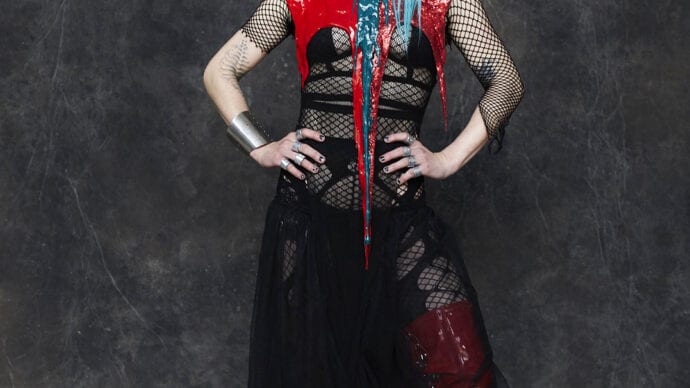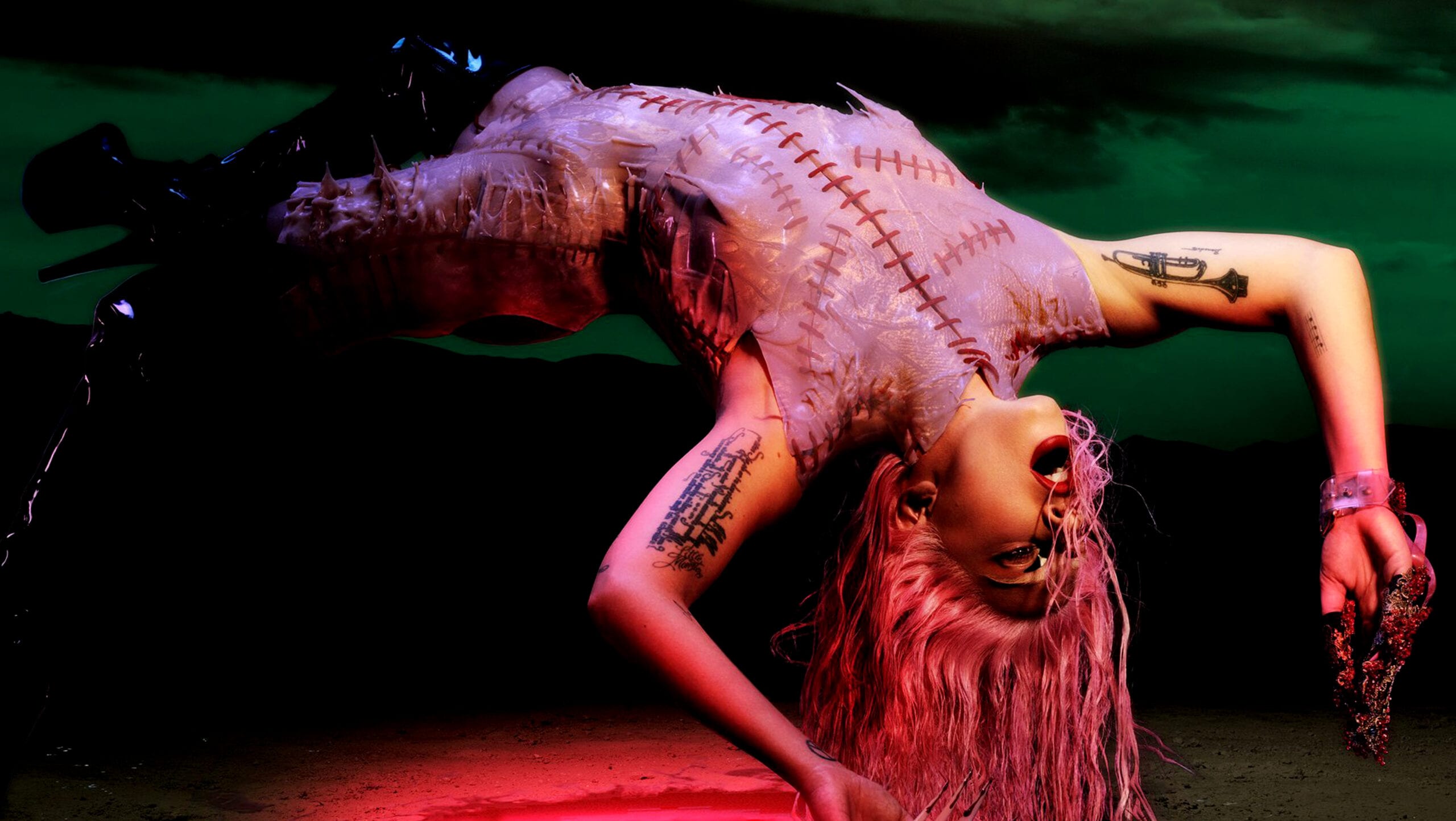For more than 10 years, Lady Gaga’s career has been a vehicle for all kinds of daring and unique artists, whose vision goes far beyond traditional tropes. And the singer’s official return to pop with her recent album Chromatica has once again gathered a unique worldwide team of creatives. On the new album—Gaga’s first major pop record since 2013’s Artpop—the cyber punk-esque cover alone is a micro gallery of sci-fi-inspired designers, from the elaborate metal-and-leather works of Spanish artist Cecilio Castrillo Martinez to Freddy Krueger-inspired razor gloves courtesy of Gary Fay. Yet one of the prominently featured artists of Lady Gaga’s new sci-fi era is Kristina Kiss, a New York-based designer. Kiss, owner of SSIK Designs, has been working almost exclusively with silicone for nearly a decade, creating striking designs and “drips” that look as if somebody just splattered you with paint. Kiss is responsible for the bright purple and pink silicone bodice in the “Rain On Me” music video (which features Gaga’s duet with Ariana Grande), as well as the pale pink, stitched-up bodysuit in the promotional photoshoot for Chromatica that looks like it’s made out of the skin of some unknown creature.

Credit: WAXenVINE Photography Scott Irvine & Kim Meinelt
Both designs look like they came straight from outer space. From a care-free, neon-lit planet called Chromatica, to be exact—a place where aliens rely on dance therapy to combat their existential angst. It’s no coincidence that silicone is Gaga’s latest concept: “Silicone” was the opening word of Lady Gaga’s underrated 2009 song, “Dance in the Dark,” which also featured the catchy “She’s a mess/ She’s a mess hook.” Now, 10 years later, Kiss is dressing Gaga in beautifully messy silicone looks. For Kiss, creating striking futuristic art has always been her preferred method of fighting her own demons while simultaneously making waves in the adult wonderlands that are New York City’s nightlife and fashion scenes. She’s been running in the same circles that inspired Gaga’s original songs about partying and identity; but while they share similar grotesque aesthetics, the Chromatica promotional campaign marks their first collaboration. Kiss isn’t a stranger to working with celebrities. Over the year she’s dripped silicone on LGBTQ2 icons like Debbie Harry, Neil Patrick Harris, Billy Porter, various RuPaul’s Drag Race queens (including Season 10 winner Aquaria) and the cast members of The Greatest Showman movie and Gotham TV series. And she never missed a beat when it came to creating bold looks for her own social calls and performances. Xtra spoke with Kiss about her silicone creations, working with Gaga and her advice for up-and-coming queer designers. This interview has been edited for length and clarity.
Can you guide us through your creative journey?
I come from the Poconos, Pennsylvania. A fun fact: I was a principal’s daughter. I came to New York to study accessory design at the Fashion Institute of Technology (FIT) and got my BFA in four years. After I graduated, I worked as a footwear designer for many different companies—I still do that on a side as a freelance gig.
How did the Gaga collaboration happen? What was the process like?
Nicola Formichetti’s styling team [Formichetti is Lady Gaga’s fashion director] reached out to me. Nicola’s good friends with Aquaria, so I believe I got on their radar through RuPaul’s Drag Race. Several drag queens have worn my stuff: Aquaria, Shuga Cain, Jan Sport, Brita Filter, Scarlet Envy and Trinity The Tuck. The team reached out and asked if I wanted to collaborate. I came up with ideas and showed them. For the “Rain On Me” music video, they had an idea of the aesthetic, colours and the styles they wanted based on what I’ve done—then I did my own thing. https://www.instagram.com/p/CAjhs9FgRPM/ While I was studying, I got an idea of what the nightlife in NYC was like. I started hosting parties with Susanne Bartsch and Kayvon Zand. I was in a band with David Barton called Liquid Blonde, running around all over the East Village and Lower East Side. I like that you can transform yourself into whatever and whoever you want there and create your alter ego. [That’s how] I slowly started developing my own aesthetic. While doing all of these things, I started understanding what I wanted my own brand to be: Ripped T-shirts, splattered paint, grimy, punky looks. I got a mohawk, I got piercings and tattoos. My brand was an organic continuation of my personal style. I like to be on the edge of scary and sexy. I was dating somebody who was into industrial rock and was surrounded by a lot of musicians. They gave me the opportunity to do art performances in between their gigs. I would use a few models to transfer the drippy, splashed vibe of my art into a stage presence.
When did you start using silicone in your work?
I was introduced to silicone about 10 years ago. It’s usually used in FX makeup and face prosthetics and mold making, but nobody ever used it in fashion. I was playing with it, dripping it around and on me and on my forms, and I really got a hold of it and decided to focus on that one medium. I think that’s what you have to do in order to grow a brand: Have an aesthetic that people recognize. For all these years, my personal style remained a great platform for my brand. I would create my own costumes for events, using silicone for these creepy/sexy looks. People got interested. I went from working with different musicians and performers to drag queens. In the last few years, it has really sped up. RuPaul’s Drag Race has been a huge help. Patricia Field has been repping my brand—she’s really helped to get the word out about my product. Now I’ve got Gaga, which is insane.
Is working with silicone dangerous? Does it need to be hot?
It is skin safe—remember that it is used for facial prosthetics! It’s not hot, it’s not toxic, there’s no smell, which is all also beneficial for me. I still wear gloves, and if I use any other glues I wear a protective mask.
Is it safe to assume that you identify as a queer artist?
I don’t really judge people or label anybody, but I am definitely a part of the LGBTQ2 community in every way.
I’m not sure if you’re allowed to say anything, but can you hint about whether you plan to continue working with Lady Gaga?
I do. Now I have good relationships with her styling team and they have an idea of where I would fit—and I can even pitch some ideas. I think I am on their minds now. So yeah, there are definitely many opportunities to work with her in the future. I’m hoping this is only the beginning. Stay tuned!
Did Gaga’s fans already reach out to you and ask to sell them the replicas of the outfits you’ve created?
Oh, they definitely have. The thing with my work is that I can never fully replicate pieces. Silicone is a very organic medium, there’s only so much you can control. But I can do something similar or inspired by that original piece. I also don’t love to make an exact copy of what I’ve done, but I am definitely open to designing something in the same colourway—like the “Rain on Me” pink and purple piece. There are some things that I will not replicate. For instance, that stitched-up nude suit that is in Gaga’s album art because that suit is now very iconic to that record. Let’s just end it there.
You’ve designed silicone outfits for a number of RuPaul’s Drag Race queens. What do you think of the sudden, almost universal fame of drag culture in the last several years?
I’m so happy about it. Drag queens inspire me so much; I couldn’t do half the things they do performance-wise. Even the makeup. That’s a lot of skills coming together! I have nothing but respect and admiration for all drag queens. I wish I could be a drag queen when I grow up [laughs].
You still can. Or a drag king.
I can, right!
Are there any other exciting queer designers you want us to check out?
There are so many talented people I know. One fellow artist that I’ve been super tight with is Victor Hugo. His brand is Material Memorie. It’s all eyewear; he cuts most of the frames himself and then encrusts them with Swarovski. We share the same edgy, sexy, punky, glam style. He does some accessories as well. He’s the love of my life—we work with a lot of the same people, including Lady Gaga.
And finally, do you have any advice for up-and-coming queer designers? For somebody who is maybe only thinking about moving to New York? Do they need to?
From what I’ve experienced in my life, I think the main thing is to just be authentically yourself and nice. Be a genuinely nice person. Be consistent in that attitude and in your work and your work ethic. If you wanna be seen and be heard, you gotta get out there. Talk to people, show people your stuff, network, support other people, work together with people. Don’t be selfish; be a genuine human being. I don’t understand why people need to fight, burn bridges or be mean. And work your ass off no matter what. Moving to New York would definitely help you network and meet new people. Go to the events, go to the parties. But do it for a reason, not just to get drunk or high. And get your voice out there. Do it in a loving, positive way.

 Why you can trust Xtra
Why you can trust Xtra


